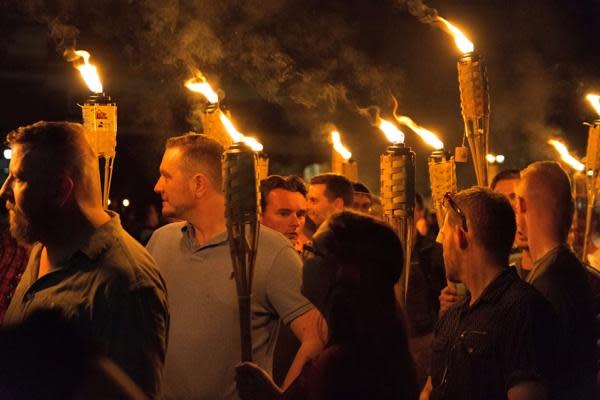Charlottesville Has a Long History With the KKK
The home of the University of Virginia, Charlottesville, has become a particularly quiet and progressive college town in recent years. In fact, 80 percent of the voters in the small city voted for Democratic presidential nominee Hillary Clinton during the 2016 election. So why would the left-leaning town, where roughly 47,000 people currently live, be chosen for white nationalist rally headed by the alt-right?
Charlottesville city council in April voted to remove a statue of Confederate leader Robert E. Lee, one of the last standing Confederate monuments in the state. The statue stands in a park that was also recently renamed from Lee Park to Emancipation Park. Although the removal of the statue is still pending litigation, white nationalists are opposing the decision in an effort to cling on to their white history.
White rights activist Jason Kessler, a Charlottesville resident who organized Saturday’s “Unite the Right” protest, blamed all "the anti-white hatred that's coming out of the city" as the reason for the rally, CNN reported.

“This entire community is a very far left community that has absorbed these cultural Marxist principles advocated in college towns across the country, about blaming white people for everything," Kessler told CNN on Friday.
However, the tearing down of the monument may not be the only reason why Charlottesville became a prime location for alt-right leaders to hold a rally. The small city’s history is muddled in racism.
The town, considered a community of the Jim Crow South back in the early 1900s, was the last in America to desegregate schools following the Supreme Court’s ruling on Brown v. Board of Education, which allowed black children to attend historically white-only schools. Despite ordering desegregation with “all deliberate speed,” in 1955, Virginia strongly resisted the ruling. Some schools even shut down in Charlottesville before finally allowing integration in 1958.
In 2015, Charlottesville was under fire for racist behavior following the violent arrest of Martese Johnson, a third-year student at the University. Johnson, a black man, was confronted by three white police officers who, after asking for identification, assumed he was holding a fake I.D.. and beat him before throwing him in cuffs. A video of the altercation went viral, sparking a nationally trending hashtag #JusticeForMartese on Twitter and bringing attention to the aggressive force law enforcement enacted on blacks in the community.
Virginia overall also has longstanding ties to the Ku Klux Klan. In a study released in 2015, researchers from Virginia Commonwealth University discovered there had been more than 2,000 KKK klaverns established in the U.S. between 1915 and 1940, 132 of which had been spread across the state of Virginia.
Just in July, Klansmen held a rally of their own at Emancipation Park, similarly protesting the removal of the statue. About 30 Klansmen attended that particular rally and were met by nearly 1,000 counter protesters.
The rally on Saturday, however, is expected to see a much bigger turnout. The Southern Poverty Law Center, which monitors “hate groups and other extremists,” estimated as many as 2,000 to 6,000 people may show up at the protest.
Related Articles

